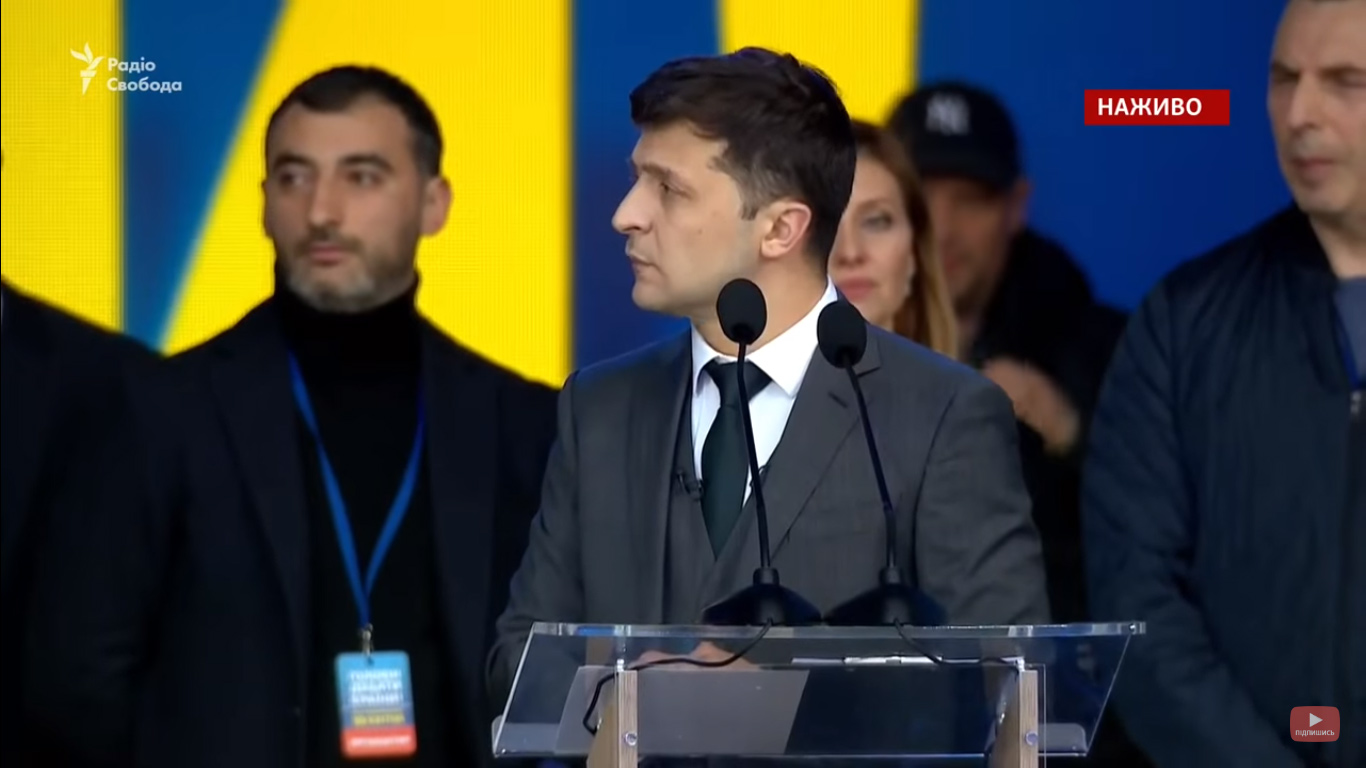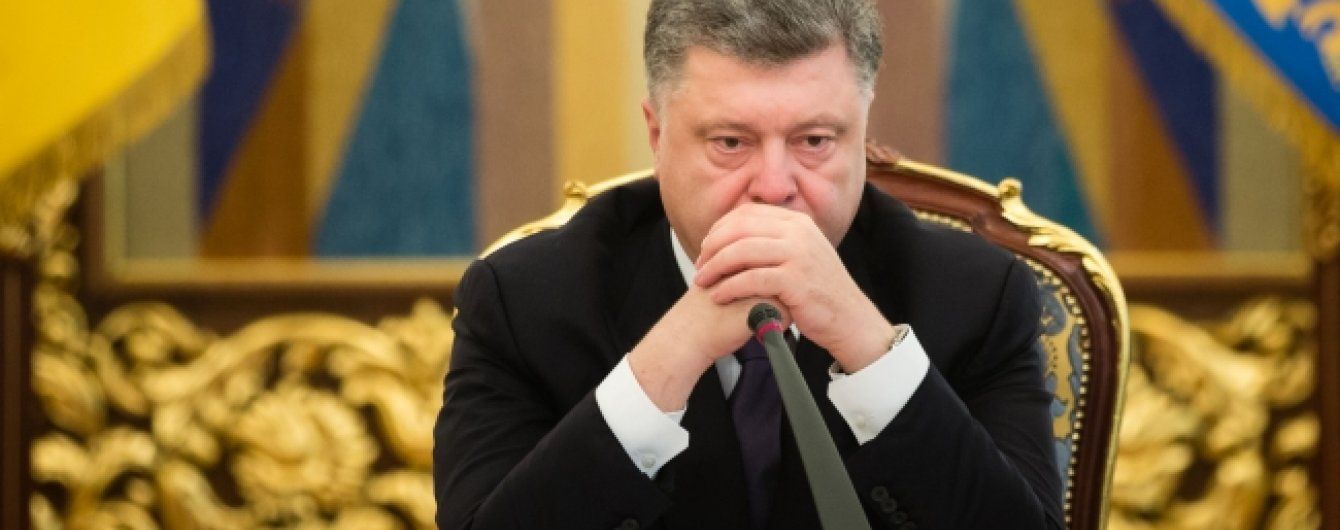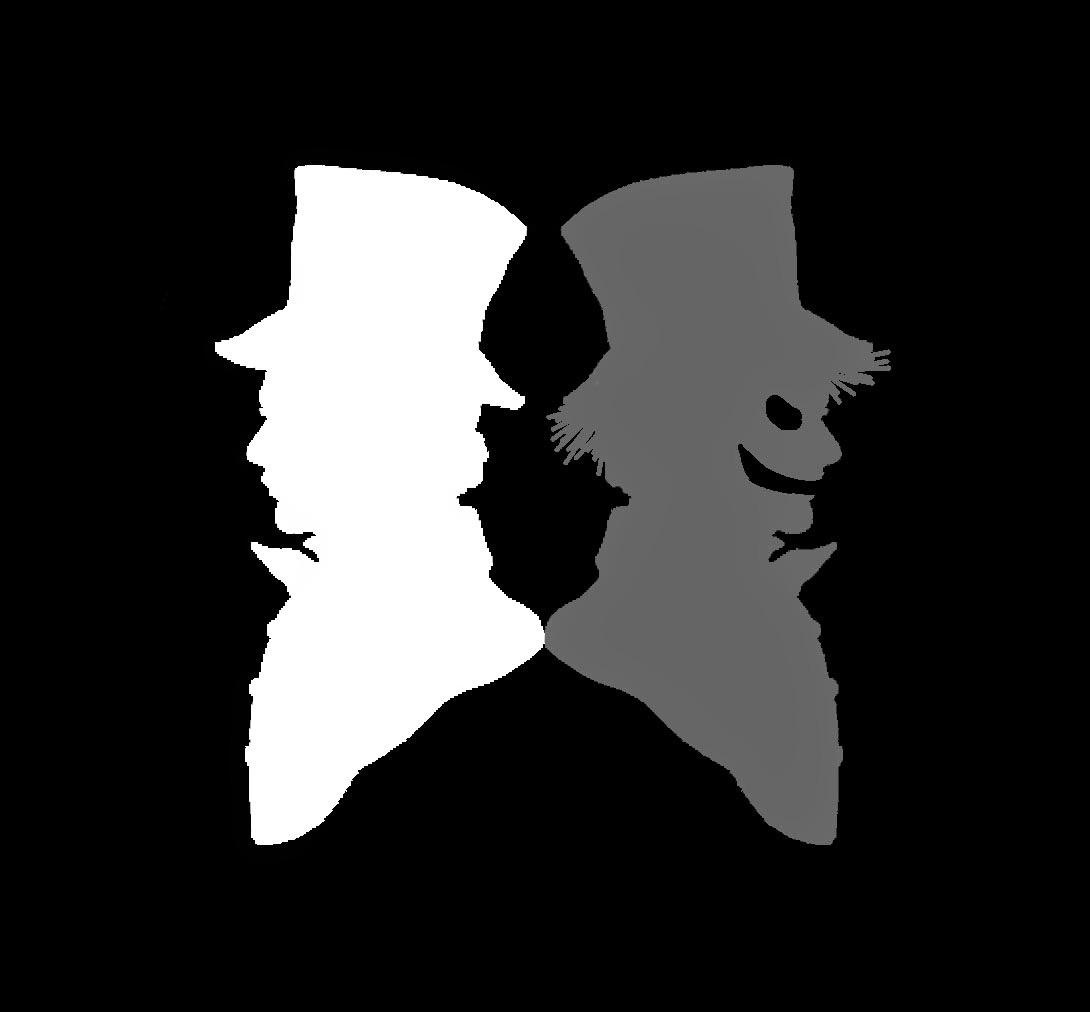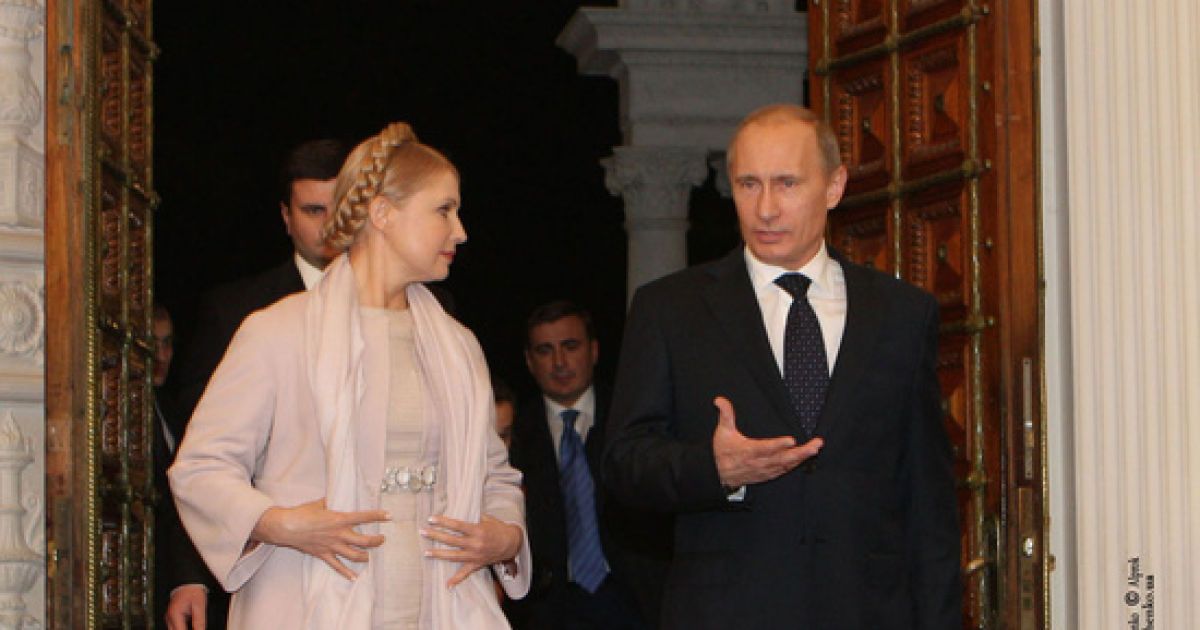Why did Ukrainian voters consider Zelenskyy a better choice than the incumbent President Petro Poroshenko?
Read also: Why Zelenskyy won
Here are some highlights of the Zelenskyy team campaign and the media background it has successfully used and can use once again at the next parliamentarian elections.
Media background
Russian propaganda
Over five years, Russian officials, press, and social media pushed multiple anti-Ukrainian narratives, in which Ukraine was presented as a failed state and the Ukrainian leadership - as incompetent losers unable to create a decent living for their citizens. President Petro Poroshenko was among the key targets of the propaganda campaigns, in which he was constantly ridiculed as a corrupt alcoholic who is plundering his own country, making inadequate decisions.
Ukrainian mass and social media
Most Ukrainian press outlets participated in creating a negative information environment, not just focusing almost exclusively on negative news like crimes and incidents, but also giving much of their airtime for critics of the government.
Social media often repeated Russian narratives, blaming Poroshenko personally or his allies for everything and anything, even shifting the guilt for the ongoing war from Russia to the Ukrainian leadership. The idea of the war being highly profitable for both Poroshenko and Putin was spread far and wide, as well as the idea that Poroshenko could "stop the war" in the East-Ukrainian region of the Donbas if he wanted to, despite the obvious fact that there are two ways of ending the war, victory or defeat.
The press and social media often presented Poroshenko guilty of the still undefeated corruption in the state, where it thrived all 23 years of Ukrainian independence, of the Russian occupation of Luhansk and Donetsk, and defeats of the Ukrainian military near Ilovaisk and Debaltseve, of the stagnating economy - despite the fact that the Yanukovych regime emptied the State Treasury before the post-Maidan authorities came to power and that currently the Ukrainian economy is growing with a positive outlook.
Supporters of Poroshenko were denigrated by labels of Porokhobots ("Poroshenko bots"). Here, parallels with the Kremlin bots - Russia's "Internet Research Agency" whose employees push narratives desirable for the Kremlin, sow hate among communities abroad and conduct other various online operations, are evident.
The term Porokhobot was coined at the TV Show "Shuster Live" on 20 February 2015 as MP Parasiuk first complained that some agency of Ukrainian trolls had emerged, later editor-in-chief of the news site Censor.net Yuriy Butusov mentioned the "trolls" as "Porokhobots" and further on at the show, former Putin's adviser Andrey Illarionov repeated the term in his speech building parallels of Ukraine with Putin's Russia.
The Russia state "troll factory" became known months after it was created, its office locations are known, testimonials of former employees of the troll agency became public, Twitter and Facebook regularly delete accounts linked to the agency.
Meanwhile, in more than four years, no evidence of the existence of such a network of paid pro-Poroshenko trolls in Ukraine has been found. Nevertheless, over several years, Ukrainian MPs, activists, and journalists propelled hatred towards "Porokhobots" on social networks. As of the election campaign time, many average social network users perceived any
supporters of Poroshenko as paid bots.
Most popular Ukrainian TV channels criticized authorities for years, ignoring the successes of the government or ascribing them to anyone starting from activists to "the Ukrainian people." Meanwhile, negative events or actions were exaggerated and often attributed to Poroshenko personally or to other personalities of the post-Maidan leadership.
Plus, two key blunders in Petro Poroshenko's policies, which constantly fueled the rightful indignation in the press, were behind-the-scenes appointments and the lack of communication with civil society and the public. In some cases, Poroshenko appointed his former business partners or close allies often made without any public debates. Meanwhile, the President had rare meetings with activists while TV viewers saw him only in official addresses and footages from various events. Presidential live comments on TV were extremely rare and he didn't take part in any TV shows to explain any of his actions or decisions. As well as the name of Poroshenko was mentioned in the media when his proteges were involved in suspected corruption activities.
The President admitted both failures only after the first round of the elections saying,
"Strategic communication was fully ruined. Decisions were taken behind-the-scenes. And even when they were absolutely proper, they didn't establish trust among the society," Poroshenko admitted at the TV show Svoboda Slova ("Freedom of Speech") on ICTV channel.
Both policies and their consequences contributed to the mistrust as in Petro Poroshenko in person, as in the country's leadership in general.
Anti-corruption activists
It so happened that during the rightful fight against corruption, the activities of various anti-corruption activists shifted the focus of mass media from successful anti-corruption structural reforms to the justice system which is still yet to be reformed. This contributed to the nothing-is-changing mood of the public.
In her article "How the West Helped Put a Comedian in Reach of Ukraine’s Presidency" Mary Mycio wrote,
"The almost exclusive focus on wrongdoing hasn’t created a “toxic atmosphere” for the corrupt. Instead, it seems to have created a toxic atmosphere for everyone, fueling such powerless outrage, anger, and cynicism that vast swathes of the public are willing to vote for a virtual candidate."
Moreover, the active struggle against corruption and its excessive press coverage at times made corruption appear as the main problem of Ukraine, sidelining the Russian aggression which actually threatens the very existence of Ukraine as a state.
No official reaction on most fakes
The presidential administration and President himself ignored almost all fakes, probably believing that the achievements of his team are the best way to fight fakes. However, the absence of a reaction to repeated accusations could be often perceived as a silent acknowledgment of guilt. Various sources repeating the same allegations convinced many people of the truth and relevance of the accusations.
Zelenskyy's campaign: Populism 2.0
"Servant of the People"
In fact, the presidential campaign of Zelenskyy started back in 2015 with "Sluga Naroda" ("Servant of the People"), a Russian-language comedy TV series shown on 1+1. The series depicts Zelenskyy as Vasyl Holodorodko, a divorced history teacher working at a Russian-language school in Kyiv who suddenly becomes president after a video in which he reviles the authorities goes viral. No campaign or elections are shown in the series.
The state officials are depicted totally corrupt, the previous president is presented as an alcoholic, the IMF acts as an organization intending to harm Ukraine, rare Ukrainian speakers in the series are, as a rule, villains.
Zelenskyy massacres the Verkhovna Rada as Holoborodko in the teaser of the second season of Sluga Naroda.
And the corruption fighter Zelenskyy is shown as a de-facto tyrant, possessing absolute powers: he appoints a priest he's familiar with as a judge, seats his cronies on government positions, reduces the number of parliamentarians and fully controls the parliament, and even later mass shoots MPs with submachine guns. Any decision he makes is accepted for execution without any criticism. Of course, everything is done for the welfare of the people.
The song soundtracking the closing credits of the episodes gives a glimpse into the intention behind the TV series,
"We'll choose him soon, so we should know him,
His father, mother, who are his brothers?
He shouldn't be yet another bastard,
Bandit, thief - we need a servant of the people.Yoo-hoo, we'll have a servant,
Our people will have, finally, hooray,
Yoo-hoo, our own servant,
Country, meet him from both sides of Dnipro River."
"We'll soon live better," stated the song, "if we'll elect him, we'll be able to deposit money, accumulate money for pension," since when he would come he'll "punch corruption in the guts."
Since 2015 premiere, the 1+1 station aired three seasons of the series and posted all episodes on YouTube, the last season was broadcast during the real presidential campaign in 2019.
Sluga Naroda wasn't a simple TV show, it can be called the longest political commercial ever.
Social media
The HQ of Zelenskyy heavily used social media to mold public opinion and engage people into campaigning. The team Zelenskyy asked people on social media what they would like to see in the program of candidate Zelenskyy, urged to campaign online telling "the truth" about Zelenskyy, called to post questions they would like to pose to Poroshenko on debates and so on. The people were used in the way that they would have engagement with the "grassroots candidate."
Most of the Ukrainian politicians have Facebook accounts, the next popular platform is Twitter. Meanwhile, the team Zelenskyy focused on Telegram and Instagram, which weren't widely used by politicians and campaigners before, using Facebook and Youtube as well.
Investigative journalists of Bihus.info stated, "The budget for internet advertisement of the Zelenskyy HQ in the second round [alone] was about $300,000. It included, in particular, funding bots on social media."
In his interview to Hromadske, Zelenskyy's digital campaign manager Mikhaylo Fedorov denied using bots and declared a much lower amount of $200,000 ostensibly spent for the ads in both rounds of the elections,
"I guess that the budget of the [online] campaign is not higher than 5% of the entire campaign cost. The main funds [in the online campaign] were used for ads on Facebook, Instagram. It's not a secret. I can tell that, for now, we have spent up to $200,000 for the entire campaign on Facebook, Instagram, Google, Youtube in four months."
The HQ of Zelenskyy used the Telegram messenger as a major medium for online communication with voters, where volunteers replied to typical questions using the prepared replies collected in "Ze Book" manual, according to Fedorov.
Fighting imaginary bots with a very real troll farm
In the course of the presidential campaign, many Ukrainian users of social networks found that their tweets and Facebook posts were inundated by casual commenters aggressively whitewashing Zelenskyy, denigrating Poroshenko, and harassing the author of the post and those who supported the author's opinion. Sometimes, amid such raids, several comments with the same arguments could be posted.
As it later emerged, the Zelenskyy team had created what they called "The Mobile Online Group." It was a volunteer group to coordinate the "opinion attacks" of Zelenskyy's supporters on the otherwise minded. An interesting point is that only a Facebook account was required to participate in the group, which means that Russian or any other foreign citizens could freely participate in the campaign by coordinated harassment of the political opponents and boosting social media shares and likes for posts containing desirable opinions.
This is how it was presented on the official site of the campaign:

"We know that closer to the election day, the authorities are preparing an attack of bots which will lie and manipulate people on Facebook, We will stop it!" assured the creators of the troll farm.
This is how the section "How a member of the mobile online group can help" described the activities of the group:
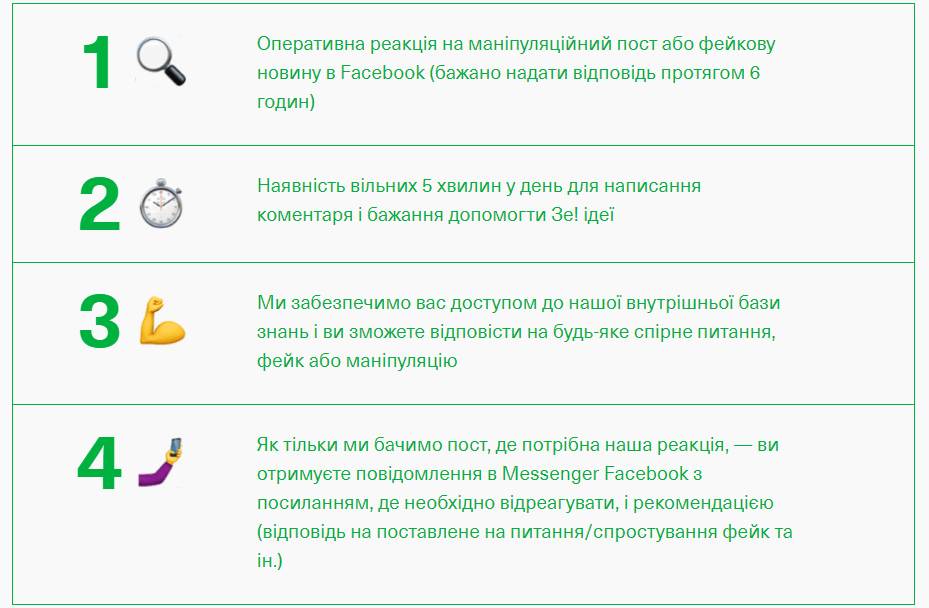
And here is an example of a real task, urging to post positive comments under a campaign's official post on Instagram:

Translation: "Thank you for joining. You'll receive first comments soon" "Hello, all. Probably, everyone can see how much mud is slung in recent days. From paid rallies near the HQ up to the video showing the long-haul truck knocking down Volodymyr. But gambling on the topic of the unity of Ukraine in such times isn't acceptable for anyone. What is your opinion? Write about it in the comments under the Instagram post. We'll be very thankful. Open [the link]"
In his interview with Hromadske
, Zelenkyi's digital campaign manager Mykhailo Fedorov denied using bots in the campaign, and technically he was right since the comments were not software generated or automatically posted. The more correct term would be trolls.
"We have developed our own system," explained Mr. Fedorov.
Asked "You want to say that all those endless comments under our, in particular, segments, streams where the green hearts and "Zelenskyy is our president" pop up - that's all living persons?", Fedorov explains:
"Yes, I can explain why our people react this way. Because it is systematical work. The volunteer contact center is only one of our projects. We have 10-15 of them."
Later in the interview, he explains how the Zelenskyy's troll farm works.
"As an alternative to the bot farms, we created the project "Ze People": lots of fakes are propelled against us, supported by bots. We need help to react to the fakes so that you could come and express your position. Everyone interested, press a certain button and subscribe to our chat-bot mailing list. We tell to the people: such a fake exists, enter and react, express your position. We don't say which words they should use, they enter and continue writing about their position," Fedorov told.
It's unclear whether the mentioned "Ze People" is the same as "The Mobile Online Group" - Fedorov's description matches, but it doesn't mean that it's the same project.
Given the access to the database of prepared answers about the great reformer Zelenskyy and the maintained atmosphere of "fighting the old corrupt system," it's not hard to get what kind of comments such coordinated raids on the people labeled as "paid bots" could produce.
Marketing "Ze candidate" as a product
In his interview with Hromadske, Fedorov disclosed how the marketing strategies were used for the political campaign. In the first two months of the campaign, they had united people who created, as he states, about 2,000 unofficial online communities to support Zelenskyy on FB, Instagram, and Telegram. The Zelenskyy carried out seminars and webinars to teach their active supporters how to maintain their web pages, how to talk to people, how to keep the new converts vigorous.
Zelenskyy's campaign was rather selling a commercial product than a traditional presentation of a candidate. The participants of the campaign maintained the image of real-life magician Holoborodko for Zelenskyy. A full-feature brand book was developed for the campaign, offering commercial fonts used for branding for free and providing guidelines to use a logo, quotes, additional texts, print the logo on clothes, and explaining the best practices.
The campaign was almost entirely virtual. The Zelenskyy team didn't carry out any rallies, performing free comedy shows by Zelenskyy's Kvartal 95 studio instead. The candidate avoided publicity as much as possible - he didn't give comments to independent journalists, visited only shows on Kolomoiskyi's 1+1 where he voiced prepared texts. His political consultants and unofficial advisers talked to the media instead of Zelenskyy, stating that their opinions represented his position. In fact, they did act as sales managers who foisted the product Zelenskyy (read "Holoborodko") on the TV audience.
The campaigners released several videos in which Zelenskyy challenged incumbent President Poroshenko. The comedian was portrayed as his TV series persona. Meanwhile, real-life Zelenskyy remained in the shadow, since he is tongue-tied despite being an actor. The real candidate could barely go off-script.
The debates between candidates of the runoff round took place on the last day of the campaigning. Zelesnkyi mostly read multiple scripted allegations and accusations familiar to TV audience by Russian and Ukrainian media propaganda. Most of the statements had nothing in common with reality but were taken for granted by most of the audience after being repeated for five years.
Throughout the campaign, Zelenskyy offered very few details on what he was going to do to address the challenges Ukraine faces. He didn't promise anything concrete and such understatements allowed the TV celebrity to unite various voters ranging from Russian supporters throughout politically passive TV viewers up to patriotic Ukrainians disappointed with the current leadership.
The slogans of the campaign were:
- Ze!president is a servant of the people.
- No promises, no excuses.
- Spring will come, we'll bed out (or lock up, which was implied by the pun)
- Spring will show who stole and where.
- Let's do (implying "finish") them together.
- March 21: The end of the era of poverty.
- March 21: The end of the era of greediness.
The team Zelenskyy avoided giving any details on how they would achieve any of their vague promised goals. The candidate remained a product which would make your life better by a miracle.
The 1+1 TV channel run day-long TV marathons of TV shows featuring Zelenskyy on the days of silence when no campaigning is allowed prior to the election days.
Zelenskyy officially presented his team only two days before the runoff of the elections as experts in certain fields. Meanwhile, after his victory, at least two of the twenty experts have already said that they are not going to be ministers. And we still don't know whom Zelenskyy will offer after his inauguration on government positions.
Just after the election, Zelenskyy campaign's key political adviser, Dmytro Razumkov, has already publicly acknowledged that President doesn't possess powers to reduce the cost of utility bills and lock up corrupt officials, de facto admitting that the campaign was purposefully based on populistic promises.
Read also:
- Poroshenko has suffered fate of Winston Churchill, Khandurin says
- Meet team Zelenskyy: who are the allies of comedian striving to become Ukrainian president
- Ukraine votes in second round of presidential elections: live blog
- Five years of Poroshenko’s presidency: main achievements and failures
- Sociology of Ukrainian elections: who votes for Zelenskyy/Poroshenko and why
- The difference between Zelenskyy and Poroshenko: piecing together the evidence
- Only 1% of diaspora Ukrainians voted in presidential election. Should the system be changed?
- Ukrainians once again are voting for someone they hope has a magic wand, Portnikov says
- Analysis: Among presidential candidates Poroshenko is the key target of hate speech on “Russian Facebook” VK
- How pro-Kremlin think tanks spread propaganda in the West
- Digital populism of Ukrainian presidential campaign has inflicted a deep wound, Deresh says
- How Russian propaganda denigrates Ukraine with disinformation
- Ukraine-related narratives dominate Russian propaganda – disinformation watchdogs
- The Kremlin’s chaos strategy in Ukraine and its helpers
- Fifty shades of Ukrainian populism: Tymoshenko, Zelenskyy, and the Chiaroscuro principle

